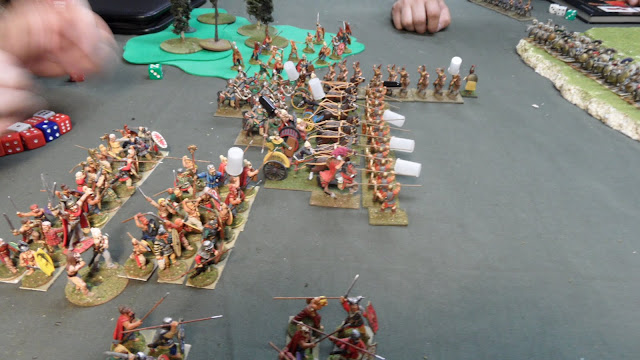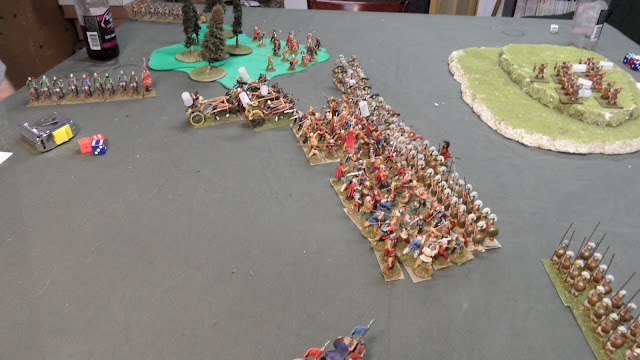Most readers will recall the stunning bit cartography that I created to show the game table, but (just to show off) I have posted it below. You will, of course, now note that it reflects the position of the troops at the beginning of play. The Galatians had concentrated the warbands into a dense block in the center with the lighter troops and cavalry assigned to cover the flanks. The Army General led the warbands while the lesser leaders were in charge of the left-flank force of chariots/cavalry/light infantry and the right-flank force of heavy cavalry and light infantry.
The Greek players decided to spread the army across the field to leave the ferocious Galatians little chance at turning moves. Aware of the Phalanx, Long Spear and Uphill rules they cunningly placed the less-than-heroic Subject Hoplites on the hill on their right flank, supported on either side by the Spartans and cavalry. The Spartan General (who was also the Army commander) stood nearby to ensure they performed their duties as expected, he also commanded the Spartan phalanx, and the Thorikatoi. The Athenian General lead the two Athenian Phalanxs and the one unit of Subject Hoplites that were sandwiched between. The remaining general commanded the cavalry and the light troops (cleverly taking advantage of the Marauders rule).
The Galatians responded by throwing the chariots at the Thorikatoi in a furious charge, which gained support from the Light Infantry emerging from the woods. Meanwhile three of the warbands advanced one move in the center (they had failed the command roll but they had charge orders and the Special Rule "Eager" which allowed them a free move if they had charge orders) this placed them close enough to engage the psiloi with short-range missle fire the result of which was the breaking of the psiloi slingers. On the right the light infantry managed one move forward toward the psiloi javelinmen but did not get in range. The heavy cavalry failed their command roll but also advanced one move behind the light infantry as they were Eager and had charge orders.
The chariot charge showed the strength of the Long Spear Special Rule, charging chariots and cavalry must test to become disordered, which the chariots failed. Striking the Thorikatio they were only able to push them back after inflicting a couple of hits, the Greeks did almost as well in reply. This gives us the situation in photo #1;
The next turn saw the Greeks charge the flank of the victorious chariots with the Medium Cavalry that had rounded the hill, this was executed by a daring and brilliant move by the division general who bellowed "Follow me!" and proceeded to make three moves striking the chariots exposed left flank and adding his full quota of dice ( in Hail Caesar a general may add his inspiring personality to the fight, the more he inspires the troops the greater the risk of injury of death, the Greek commander was lucky to avoid becoming a casualty). The chariots now had to divide their fighting dice between the bothersome Thorikatoi and the newly-arrived cavalry (under the rules a unit has to assign at least half it's dice to fight a unit to the front, it may then assign the remaining dice to flanking units) They failed to make much of an impression on either and were forced to recoil after taking a Break Test. On the other flank the Greek psiloi advanced and engaged the Galatian Light Infantry with missle fire causing them to take a break test which they failed, promptly scurrying behind the Heavy Cavalry for protection (if a missile attack scores a "6" on any of the dice the target unit is forced to take a break test). On the Greek right the Subject Hoplites spread out into a line along the forward edge of their hill.
Seeing the chariots in a bad way the Galatian Heavy Cavalry and the left-flank general moved to support the chariots, this again forced the Thorikatio back (excellent rolling on the Break Test Table saved the Greeks here) but did not break them, both the chariots and the greek infantry were rapidly approaching their Stamina ratings. The bulk of this melee was blocking the advance of the left side of the warband division and slowed their forward movement. On the Galatian right flank the heavy cavalry declared a charge against the Greek skirmishers driving them back against their supports (the rules allow skirmishing infantry to Evade charging enemies by taking a free Order and taking a Command Roll to see how far they get).
A close-up of the melee in the center after the Galatians had re-enforced the chariots
A larger view,
The light troops have finished their business and the heavies are lining up for the real fight
The Thorikatoi fall back as the both main line close in, a view of the center
On the left the pesky psiloi trades shots with the cavalry, forcing the cavalry to retire
The Galatian lights advance again to assist the cavalry as the Athenian left advances (ever so slowly) around the extreme flank
The Galatian line advances to strike the center while the cavalry holds the Subject Hoplites in place
The Greek lines forms awaiting the Galatian onslaught, in the far distance the Greek cavalry have rounded the woods and are now on the Galatian flank
The threat posed by the Greek flanking cavalry has stripped the chariots of the supporting heavy cavalry, the warbands have struck home led by their general who (true to heroic form, adds three dice), the Spartan general joins the fray unwilling to be outshone by the barbarian he also contributes three dice to the fight, while the very tired Thorikatoi cheer from the hilltop. The Greeks (using Long Spear, Phalanx and Close Order) withstand the attack and both sides suffer heavily.
As the Galatian heavy cavalry form up to charge a dangerous gap begins to appear in the center of the Greek line. The Athenian General stands between his units ready to add his inspiration to whichever fight looks the most needful.
The irrepressible psiloi send the Galatian lights packing once again and exchange missiles with the Heavy Cavalry while the Athenian left flank grinds slowly on.
What Price Glory? The Spartan General dies in a way the would make his wife and mother proud; at the head of his men, facing the enemy general, who also suffers a wound and must withdraw from the fight. Despite the loss of their leader the Spartans throw back the Galatian warband who are now on the brink of exhaustion. Inspired by his heroic sacrifice the Subject Hoplites would also drive back their opponents.
Trying to keep up the pressure on the Greeks the Galatian Heavy Cavalry slam into the Athenian hoplites while the other unit threatens the Subject Hoplites.
Both side catch their breath and try to restore order and stamina during the break, and a newly promoted Spartan General joins the ranks.
The Galatian light infantry gather their nerve to confront the advancing Athenian Hoplites. This is made easier as the the Heavy Cavalry have finally driven off the psiloi.
The Thorikatoi, having rested, advance off the hill to support the main line as the Cavalry and the Hoplites trade blows.
The Galatian general inspires his troops to attack again before the Greeks regain too much Stamina.
Who would dare not to be inspired by such an imposing Hero?
With the center cavalry unit repulsed the remaining unit slams into the Subject Hoplites and begins to push them back.
As the Galatians attack the Greek line once again both armies have units that are dangerously tired. The Athenian Hoplites have driven off the Heavy Cavalry but are now Shaken and facing a fresh Galatian Heavy Cavalry unit.
Even the mighty Spartans are looking concerned as almost all the units in both sides have been reduced to Shaken status by the furious level of combat.
With the Athenian General busy inspiring his shaken troops the ever-present psiloi advance to support the crumbling Subject Hoplites and the Light Infantry throw themselves against the flank of the Athenian left to slow its advance. After this turn a series of fail Break Tests left the Galatians with too little of an army to carry on and they graciously conceded.
General Observations: The rules are much better laid out than Blackpowder (I hope there is a 2nd Edition of Blackpowder that uses the lessons learned) with page references listed in the text when referring to a rule. The Break Test chart has better results options in my mind. The Special Rules are what really give this set flavor. The basic units are pretty straightforward in how they operate under the rules, it is the tweaking that you can do with the special rules that gives the troops personality and granularity. The summary of special rules could probably have been placed at the end of the book along with the other playing aids but now I feel as if I am nit-picking.
Observation #1: Phalanx Rocks! being able to treat defeats by up to 2 as a draw is huge, it makes any Phalanx troops very tough to defeat in the first round and gives them lots of staying power. It neatly simulates the solid nature of close-order infantry with large shields.
Observation #2: Long Spear is very effective at protecting the troops with them, the disorder effect against cavalry is very important given the high Clash value that some have, this combined with the Phalanx creates very powerful infantry.
Observation #3: Eager can make up for a lot of crappy dice rolling. There were several turns in which the Galatian army would have exhibited very little action if they did not have the Eager Special Rule, the ability to make at least one move in the face of a bad roll will keep the army closing in on the enemy.
Observation #4: Fanatic creates troops that are powerful on the attack and stay that way as long as things are going well but will crumple if the tide turns, this is particularly effective at recreating the reported historical behavior of the Celts.
Observation #5: Wild Fighters provides the unit with this Rule powerful first impact that lacks real staying power, sort of a glass hammer; break the enemy the first turn or you are in trouble. Again, this rule given to Celtic troops will simulate the historical prototype nicely.
Observation #6: Close Order is the ultimate "save it for later" tactic. It is allowed to Heavy Infantry with shields, you will strike at a -1 and save at a +1 while doing so, meaning that you are hard to hurt but are not terribly dangerous. This rule is very useful when facing enemy troops with a high Clash value but weaker Sustained values, or troops with significant bonuses for charging such as Wild Fighters. The Greeks used it several times to blunt Galatian attacks.
Right now I am giving Hail Caesar a big "Thumbs Up". If you are interested in Ancients and do not care for chart -driven rules give it a look.























No comments:
Post a Comment